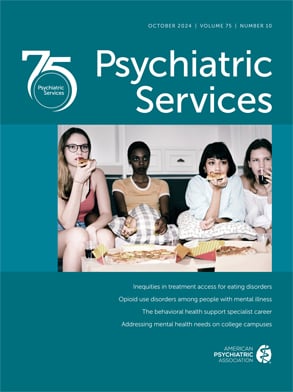Depression is frequently undiagnosed, untreated, or inappropriately treated when recognized in primary care settings (
1,
2,
3,
4). Recent intervention studies have provided compelling evidence that collaborative care can improve the detection and treatment of depression in a cost-effective manner (
5,
6,
7,
8,
9,
10,
11,
12,
13). These interventions focus on improving quality through better integrating primary and specialty mental health care. Elements of evidence-based practice include guidelines and screening tools, care management, psychiatric consultation, and computerized depression registries.
However, existing financial and organizational structures often impede incorporation of these elements into routine practice. Thus attention has increasingly focused on the organizational and payment context within which depression is treated. Better alignment of contractual relationships, payment methods, and performance incentives may be key to the successful adoption and dissemination of evidence-based clinical practices (
14,
15).
Because many individuals with depression receive mental health care services through Medicare and Medicaid, disseminating evidence-based depression care in the public sector warrants attention. In this column we identify factors that distinguish quality improvement for depression in the Medicaid program and describe system-level changes made by a nonprofit Medicaid health plan—Colorado Access—to improve depression care under a demonstration program funded by the Robert Wood Johnson Foundation (RWJF).
Improving depression care under Medicaid
Although both state Medicaid agencies and private purchasers grapple with many similar challenges in adapting systems of care to incorporate and sustain treatment innovations, some key differences in population characteristics, provider payment incentives, and agency objectives are worth noting. Medicaid enrollees experience a higher rate and severity of depression than privately insured individuals. In a ten-state SAMHSA Medicaid study, 17 percent of adult enrollees were treated for major depression and 32 percent for minor depression and anxiety disorders in 1995 (
16). Enrollees with disabilities who receive Supplemental Security Income (SSI) constitute the most significant component of mental health service users within the Medicaid population. In 2002, a total of 1.29 million SSI recipients aged 18 to 64 years (34 percent) had a mental disorder (
17). Within this Medicaid population of persons with disabilities, enrollees with depression are also more likely to experience co-occurring medical, psychiatric, and psychosocial problems.
Medicaid beneficiaries with depression receive care in various provider settings, including federally qualified health centers, hospital-based training clinics, community mental health centers, and private primary care and specialty practices. Organizational cultures and economic incentives to enhance quality differ by provider type and payment source. Medicaid managed care creates opportunities for better integration of depression care through greater financial flexibility under capitation. However, treatment of individuals with depression can be time intensive, and pure capitation payment systems may effectively penalize primary care clinicians from taking on more clinically complex patients. This problem is exacerbated for clinicians who treat depressed Medicaid enrollees with co-occurring medical or psychosocial issues. Primary care clinicians who are paid on a capitated basis may also be more likely to refer Medicaid patients to specialty care, even if effective treatment could be provided in primary care. High referral rates may create further inefficiencies if the specialty providers become overloaded and there are inadequate resources to treat the most severely disabled enrollees. Fee-for-service arrangements may also penalize primary care providers if Medicaid does not reimburse for a primary diagnosis of depression or if auxiliary services, such as care management, are not reimbursed.
For private-practice primary and specialty providers, Medicaid payments are often lower than commercial insurance and discourage provider participation. Payment issues pose less of a problem for federally qualified health centers, in which providers typically receive cost-based reimbursement through federal wraparound payments. Different provider cultures may also have different levels of receptivity to payment incentives.
State Medicaid agencies' core objectives also differ in important respects from the central considerations that motivate private purchasers. Although there are important political and structural differences in how these agencies operate across states, they share a common orientation because of their traditional links to welfare and their role in caring for populations with disabilities. State Medicaid programs tend to offer more comprehensive mental health benefits, with lower cost-sharing, than private employers and do not impose exclusions for preexisting conditions or waiting periods for coverage. Public and private purchasers also value somewhat different quality improvement outcomes. In the private sector, quality improvement for depression care is often cast in terms of increasing employee productivity and retention or decreasing absenteeism and disability costs. Although state Medicaid agencies aim to improve beneficiaries' clinical functioning and ability to work productively, these outcomes are not conceptualized directly in terms of a profit motive. Rather, Medicaid agencies view public insurance as transitional, and enrollees move on and off the Medicaid rolls with some frequency. Functional improvements due to better depression care may occur only after a person has left Medicaid. State budget cycles also create barriers to investments in improved health that accrue over a longer period.
The Colorado Access Demonstration
In 2001 the RWJF launched the program "Depression in Primary Care: Linking Clinical and System Strategies," funding eight demonstration projects implementing clinical and system changes to improve the recognition and treatment of depression in primary care (
18). Four of these demonstrations were initiated by state Medicaid agencies or their contracting partners.
The Colorado Access demonstration project focused on developing and implementing a financially sustainable depression care management program using only existing health plan resources. Formed in 1994 by state safety net providers, Colorado Access includes a fully capitated Medicaid HMO (Access Health Plan) and a Medicaid managed behavioral health plan (Access Behavioral Care). The clinical profile of Colorado Access health plan enrollees resembles those of Medicaid populations in other regions; approximately 40 percent of adult HMO enrollees have a diagnosis of a mental health condition (
19). These individuals reporting a mental health condition had 2.24 times the total health care costs and 1.77 times the medical costs of other plan members. Enrollees with depression were some of the most challenging Medicaid patients for primary care clinicians to treat effectively and also had the potential to benefit clinically from care management because of their low rates of response to usual care (
19).
Given high depression rates and constrained state budget resources, Colorado Access decided to target care management to members with depression and co-occurring general medical disorders. These enrollees tended to fall in the more disabled Medicaid payment category. They also averaged a 22-month plan tenure, compared with eight months among other members. Longer enrollment created an increased likelihood that Colorado Access would observe improvements in clinical functioning and possibly reduce health care costs as a result of quality improvement efforts.
Colorado Access opted to identify patients for care management by using claims data rather than requiring screening by primary care clinicians. Data were analyzed to identify patients with diabetes, asthma, chronic obstructive pulmonary disease, and congestive heart failure as well as those who were at risk of high future costs, as evidenced by Kronick scores of 90 percent or higher (
20). Colorado Access eventually revised its risk stratification to assign patients with a combination of high Kronick scores and high past medical costs into targeted intensive depression care management. Scores from the instrument developed by Kronick and colleagues (
20) are based on the Chronic Illness and Disability Payment System, a diagnostic classification system that Medicaid programs use to make health-based capitated payments for TANF and disabled Medicaid beneficiaries.
Colorado Access care managers then screened these patients for depression by telephone. Members with both depression and these targeted medical conditions had annual medical costs that were 70 to 350 percent those of members with these same targeted conditions who did not have depression (
19). The plan paid for care management as an administrative expense and located these services at the health plan rather than at the practice level. Colorado Access also paid for psychiatric supervision of care managers and telephone consultation to primary care providers by health plan psychiatrists as a health plan administrative cost. Patient recruitment by the health plan minimized disruption at the practice level and avoided overburdening primary care providers who were already struggling to care for Medicaid patients with complex health needs. The hope was that care management and psychiatric consultation support would increase primary care clinicians' capacity and willingness to care for difficult-to-treat patients with depression.
Colorado Access involves a relatively high degree of institutional integration around its quality improvement goals for depression. Because the Colorado Access HMO and managed behavioral health care plan are business units of the same corporation, barriers to system coordination are minimal. In the health care market, clinical practice changes are particularly difficult to achieve in the absence of structural changes that affect a sufficiently large segment of a delivery system (
21). For example, if a clinician works with 15 different health plans and a single plan realigns financial incentives, this change is not likely to alter this provider's behavior. In contrast, if a majority of a clinician's patients are insured through a single health plan, that plan wields greater influence over practice patterns. Under this demonstration, Medicaid enrollees constitute a large proportion of the caseload of primary care providers in the Colorado Access network. This demonstration experience suggests that Medicaid-focused arrangements (such as Medicaid-only health plans and community health centers with large Medicaid caseloads) created opportunities for better aligning incentives among patients, health plans, and providers that often do not exist in the private sector.
Thus far, Colorado Access has enrolled more than 300 patients with depression and comorbid medical conditions into its care management program. Preliminary results of a pre-post analysis reveal clinically significant improvements in depression severity as indicated by the nine-item Patient Health Questionnaire (PHQ-9), a slight increase in medical costs over the first six months, and decreasing medical costs after six months. A more thorough analysis of the program's impact awaits a larger cohort of patients who have been enrolled in the program for more than six months and can be compared with a nonintervention matched cohort to control for regression to the mean.
Conclusions
The report of the President's New Freedom Commission on Mental Health, released in 2003, recommended that evidence-based collaborative care models for treating mental disorders be incorporated in primary care settings and paid for by both private and public insurers (
22). The implementation of eight RWJF-funded demonstration projects provides an opportunity to study how economic and organizational changes can be adapted to different institutional settings. In this column we have identified various factors relevant to quality improvement for depression care in a Medicaid context and have described one approach adopted by Colorado Access. RWJF-funded Medicaid demonstrations in Oregon, Massachusetts, and Vermont test other approaches. Given the crucial role of Medicaid in addressing the often complex health care needs of disabled and low-income individuals with depression, critical evaluation of how these demonstrations fare over the next few years will be essential.
Acknowledgments
This work was supported by grants 48042, 40860, and 48254 from the Robert Wood Johnson Foundation. Dr. Barry received a training grant (T3-MH-19733-08) from the National Institute of Mental Health. The authors thank Richard G. Frank, Ph.D., and Harold A. Pincus, M.D., for constructive comments.

